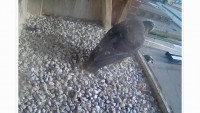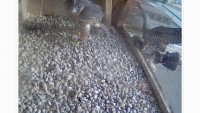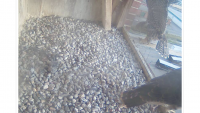Day 40: #2 ready to fledge
June 22, 2018 in In the Nest Box, lawrence peregrines, Peregrine Falcons Eastern Massachusetts, Peregrine Falcons Massachusetts
After sunrise at 5:07, the peregrines started this morning off under fair skies, little wind and temp at 56F. The day ahead calls for sunny skies, with a high near 76. East wind around 6 mph.
The two remaining chicks continue to move around inside the nest box, with time for loafing and resting, enjoying the morning shade, wing flapping, eating, and just getting ready for the moment of first flight. The female continues to watch over the chicks, sometimes from the perch and other times from just a bit of a distance.
 Around 6PM tonight, checked back in and observed one chick in the nest box. It seemed to look over and just below the nest box. After a few minutes, a small movement was seen, and it turned out to be the other chick on the ledge right below the nest box. Ir was moving back and forth, its head just visible, and then hopped up, and back into the nest box, and remained inside.
Around 6PM tonight, checked back in and observed one chick in the nest box. It seemed to look over and just below the nest box. After a few minutes, a small movement was seen, and it turned out to be the other chick on the ledge right below the nest box. Ir was moving back and forth, its head just visible, and then hopped up, and back into the nest box, and remained inside.
 Around 7PM, checked back again, and the ready to fledge chick was seen perched out on the perch pole. It sat for a while, then hopped back inside the nest box for a while, and just after 7:20 Pm hopped back out onto the perch pole….so ready for first flight!!
Around 7PM, checked back again, and the ready to fledge chick was seen perched out on the perch pole. It sat for a while, then hopped back inside the nest box for a while, and just after 7:20 Pm hopped back out onto the perch pole….so ready for first flight!!
 Many have asked, how do the chicks know when to fledge and make first flight? What prompts the final push to launch out into the world forms he nest box? From what researchers have observed over the years, there is likely little particular action by the parent peregrines to induce their young to fly. The adults may reduce the food rations at this time, for the young are quite fat. Generally, the chicks fly when they are ready and moved by their own instinct. The first flight can be quite strong, but when it lands on a nearby perch, it may remain for many hours. Food calls are exchanged, and the parent keeps close tabs from nearby. For a chick that has survived a fall from the nest, the adults will find, feed, and protect the chick until it is ready to fly away.
Many have asked, how do the chicks know when to fledge and make first flight? What prompts the final push to launch out into the world forms he nest box? From what researchers have observed over the years, there is likely little particular action by the parent peregrines to induce their young to fly. The adults may reduce the food rations at this time, for the young are quite fat. Generally, the chicks fly when they are ready and moved by their own instinct. The first flight can be quite strong, but when it lands on a nearby perch, it may remain for many hours. Food calls are exchanged, and the parent keeps close tabs from nearby. For a chick that has survived a fall from the nest, the adults will find, feed, and protect the chick until it is ready to fly away.
Literature cited:
Ratcliffe, D. 1993. The Peregrine Falcon. 2nd ed. Carlton, England: T. and A. D. Poyser.
